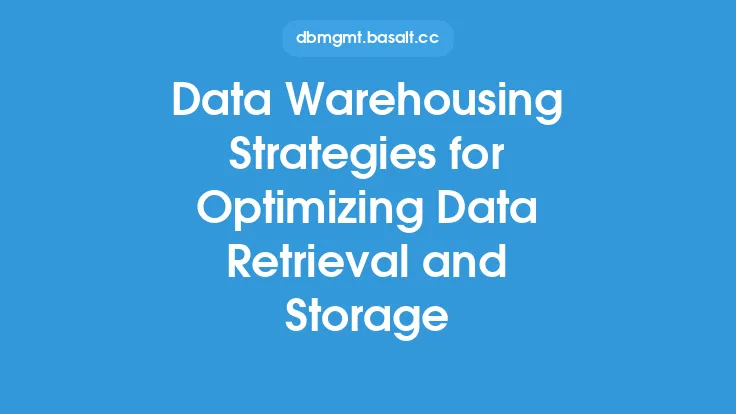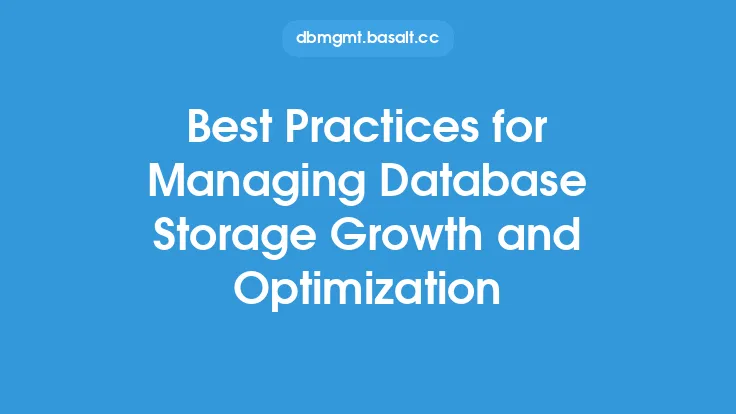Data warehousing is a crucial aspect of data management that involves the process of collecting, storing, and managing data from various sources in a single, centralized repository. The primary goal of a data warehouse is to provide a platform for data analysis, reporting, and business intelligence, enabling organizations to make informed decisions based on accurate and timely data. To achieve this goal, it is essential to follow best practices for efficient data storage, which is critical to the success of a data warehousing initiative.
Introduction to Data Warehousing Best Practices
Data warehousing best practices are guidelines that help organizations design, implement, and manage their data warehouses effectively. These best practices cover various aspects of data warehousing, including data modeling, data integration, data storage, and data retrieval. By following these best practices, organizations can ensure that their data warehouses are scalable, flexible, and capable of supporting their business intelligence and analytics needs. Some of the key best practices for data warehousing include defining a clear data strategy, establishing a data governance framework, and implementing a robust data quality program.
Data Modeling and Design
Data modeling and design are critical components of a data warehousing initiative. A well-designed data model helps to ensure that data is stored in a way that is consistent, accurate, and easily accessible. There are several data modeling techniques that can be used in data warehousing, including star and snowflake schemas, fact tables, and dimension tables. Star and snowflake schemas are commonly used in data warehousing because they provide a simple and efficient way to store and retrieve data. Fact tables are used to store measurable data, such as sales or revenue, while dimension tables are used to store descriptive data, such as customer or product information.
Data Integration and ETL
Data integration and ETL (Extract, Transform, Load) are essential processes in data warehousing. Data integration involves combining data from multiple sources into a single, unified view, while ETL involves extracting data from source systems, transforming it into a format that is suitable for analysis, and loading it into the data warehouse. There are several ETL tools and techniques that can be used in data warehousing, including data replication, data federation, and data virtualization. Data replication involves copying data from one system to another, while data federation involves creating a virtual view of data that is stored in multiple systems. Data virtualization involves creating a virtual layer of data that can be accessed and analyzed without having to physically move the data.
Data Storage and Retrieval
Data storage and retrieval are critical components of a data warehousing initiative. There are several data storage options that can be used in data warehousing, including relational databases, column-store databases, and NoSQL databases. Relational databases are commonly used in data warehousing because they provide a robust and scalable way to store and retrieve data. Column-store databases are optimized for analytics and provide fast query performance, while NoSQL databases provide a flexible and scalable way to store and retrieve large amounts of unstructured data. Data retrieval involves using query languages, such as SQL, to access and analyze data in the data warehouse.
Data Quality and Governance
Data quality and governance are essential components of a data warehousing initiative. Data quality involves ensuring that data is accurate, complete, and consistent, while data governance involves establishing policies and procedures for managing data across the organization. There are several data quality techniques that can be used in data warehousing, including data profiling, data validation, and data cleansing. Data profiling involves analyzing data to identify patterns and trends, while data validation involves checking data for errors and inconsistencies. Data cleansing involves correcting errors and inconsistencies in the data.
Scalability and Performance
Scalability and performance are critical components of a data warehousing initiative. A scalable data warehouse is one that can handle increasing amounts of data and user activity without a decrease in performance. There are several techniques that can be used to improve scalability and performance, including data partitioning, indexing, and caching. Data partitioning involves dividing data into smaller, more manageable pieces, while indexing involves creating a data structure that improves query performance. Caching involves storing frequently accessed data in memory to improve query performance.
Security and Compliance
Security and compliance are essential components of a data warehousing initiative. Data security involves protecting data from unauthorized access, while compliance involves ensuring that data is managed in accordance with regulatory requirements. There are several security techniques that can be used in data warehousing, including encryption, access control, and auditing. Encryption involves protecting data with passwords or other security measures, while access control involves restricting access to data based on user identity or role. Auditing involves tracking and monitoring data access and usage to ensure compliance with regulatory requirements.
Conclusion
In conclusion, data warehousing best practices are essential for efficient data storage and management. By following these best practices, organizations can ensure that their data warehouses are scalable, flexible, and capable of supporting their business intelligence and analytics needs. Data modeling and design, data integration and ETL, data storage and retrieval, data quality and governance, scalability and performance, and security and compliance are all critical components of a data warehousing initiative. By investing in a well-designed and well-managed data warehouse, organizations can gain a competitive advantage and make informed decisions based on accurate and timely data.





